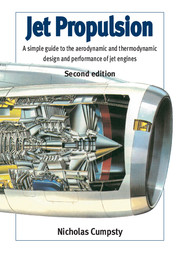 Jet Propulsion
Jet Propulsion Book contents
- Frontmatter
- Contents
- Preface
- Glossary
- Nomenclature
- Part 1 Design of Engines for a New 600-seat Aircraft
- 1 The New Large Aircraft – Requirements and Background
- 2 The Aerodynamics of the Aircraft
- 3 The Creation of Thrust in a Jet Engine
- 4 The Gas Turbine Cycle
- 5 The Principle and Layout of Jet Engines
- 6 Elementary Fluid Mechanics of Compressible Gases
- 7 Selection of Bypass Ratio
- 8 Dynamic Scaling and Dimensional Analysis
- 9 Turbomachinery: Compressors and Turbines
- 10 Overview of the Civil Engine Design
- Part 2 Engine Component Characteristics and Engine Matching
- Part 3 Design of Engines for a New Fighter Aircraft
- Part 4 Return to the Civil Transport Engine
- Appendix: Noise and its Regulation
- Bibliography
- References
- Index
- Design sheets for New Large Civil Aircraft and New Fighter Aircraft
8 - Dynamic Scaling and Dimensional Analysis
from Part 1 - Design of Engines for a New 600-seat Aircraft
- Frontmatter
- Contents
- Preface
- Glossary
- Nomenclature
- Part 1 Design of Engines for a New 600-seat Aircraft
- 1 The New Large Aircraft – Requirements and Background
- 2 The Aerodynamics of the Aircraft
- 3 The Creation of Thrust in a Jet Engine
- 4 The Gas Turbine Cycle
- 5 The Principle and Layout of Jet Engines
- 6 Elementary Fluid Mechanics of Compressible Gases
- 7 Selection of Bypass Ratio
- 8 Dynamic Scaling and Dimensional Analysis
- 9 Turbomachinery: Compressors and Turbines
- 10 Overview of the Civil Engine Design
- Part 2 Engine Component Characteristics and Engine Matching
- Part 3 Design of Engines for a New Fighter Aircraft
- Part 4 Return to the Civil Transport Engine
- Appendix: Noise and its Regulation
- Bibliography
- References
- Index
- Design sheets for New Large Civil Aircraft and New Fighter Aircraft
Summary
INTRODUCTION
It would be possible to calculate the performance of an engine in the manner of Exercise 7.1 and 7.2 for every conceivable operating condition, e.g. for each altitude, forward speed, rotational speed of the components. This is not an attractive way of considering variations and it does not bring out the trends as clearly as it might. An alternative is to predict the variations by using the appropriate dynamic scaling – apart from its usefulness in the context of engine prediction, the application of dimensional analysis is illuminating. The creation of groups which are actually non-dimensional is less important than obtaining groups with the correct quantities in them. The reasoning behind these ideas is discussed in Chapter 1 of Cumpsty (1989). For compatibility with the usual terminology the phrase ‘dimensional analysis’ will be retained here.
Using the ideas developed on the basis of dynamic scaling it is possible to estimate the engine performance at different altitudes and flight Mach numbers when the engine is operating at the same non-dimensional condition. From this it is possible to assess the consequences of losing thrust from an engine and the provision that needs to be made to cope with this at either take off or cruise.
ENGINE VARIABLES AND DEPENDENCE
Figure 8.1 shows a schematic engine installed under a wing. The only effects of the pylon are assumed here to be the transmission of a force between the engine and the wing and the passage of fuel to the engine.
- Type
- Chapter
- Information
- Jet PropulsionA Simple Guide to the Aerodynamic and Thermodynamic Design and Performance of Jet Engines, pp. 80 - 93Publisher: Cambridge University PressPrint publication year: 2003


